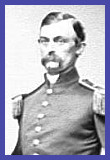| Lee
could well afford such losses but was far from admitting defeat. Jackson's
men were to arrive soon, and the plan was to renew the attack the next morning.
But much to the surprise of the Georgian's, and to the Pennsylvanian's they
had faced the day before, McClellan pulled Porter's corps back, thus abandoning
their fortified position's. Lee pursued and on the 27th threw his entire
force at Porter's corps. He caught up with them near a small creek called
"Boatswain's Creek", east of Gaines Mill. It would become known as the "The
Battle of Gaines Mill" or "First Cold Harbor". Here Anderson's Georgia brigade
would face the 2nd Brigade of Porter's 5th corps. Under command of Brig Gen
Charles Griffin, this brigade included the 9th Massachusetts (The Irish 9th),
4th Michigan, 14th New York, and 62nd Pennsylvania regiments.
Charles Griffin courtesy General Officers of the Civil War
Jackson
and Lonstreet finally arrived with their forces, and Hill, who's troops had
bore the brunt of the attack for the afternoon, now rested his men. Anderson
ordered his men to lie down in the woods, and recalled Thomas' 35th on the
right, and Harderman's 45th Georgia on the left, as these flanking regiments
were sitting farther forward than the rest of the brigade. Behind the Georgian's,
Texan and Mississippi troops under Gen Hood and Law formed up to take over
the attack on Griffin. To their right Longstreet formed his entire corps,
while to the left Jackson lined up his corps. As the first shades of duck
began to fall, the entire Confederate force attacked. Porter's men, already
battered from fighting all day, and now heavily outnumbered, put up a strong
resistance. Gradually, the weakened Union line began to break and as Longstreet's
men broke through on the Union left, the effect snowballed. Soon, Porter's
entire 5th Corps was in a hasty retreat as Longstreet and Jackson's men poured
over the crest of the hill. Hill's men, seeing the retreat, joined in the
charge and finally crested the hill that they had fought all afternoon to
possess. As darkness fell, General Lee had his first decisive victory at
a cost of 8,700 Confederate casualties, compared to 6,800 for the Union.
His exhausted men fell where they stopped, and slept that night on the hard
fought battlefield. Hill wrote "the following units are given credit for
heroic charges into the enemy - 14th South Carolina, 16th North Carolina,
22nd North Carolina, and 35th Georgia" The commander who had faced the
Georgian's that afternoon, Union General Griffin, a West Point classmate
of Hill's, would tell Col. Auchmitz, near the end of the war, that he regarded
Gaines Mill as the "hardest fought battle of the war". |

